


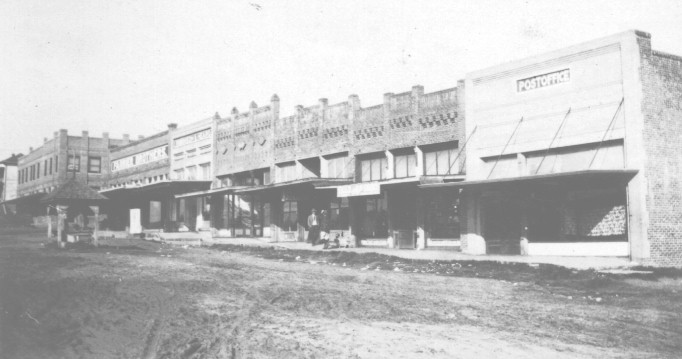
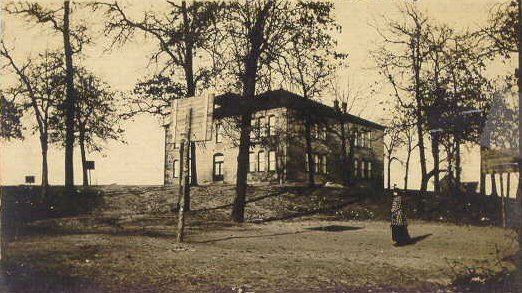
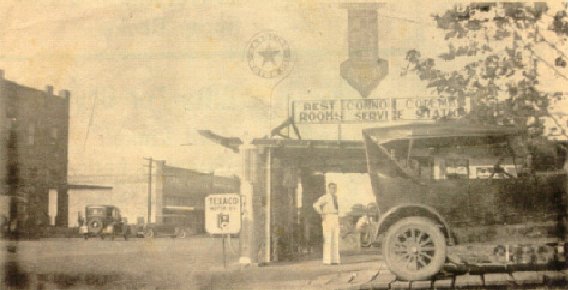
This is a newspaper photo taken in the 1920's atop the Omaha hill looking eastward. On the left is the Omaha State Bank, in the center is the Omaha Mercantile Company and on the right is the Connor-Coleman Texaco Service Station. The automobile on the extreme right is a 1927 Ford Touring Sedan and there were no foot pedals. Everything was operated by levers.
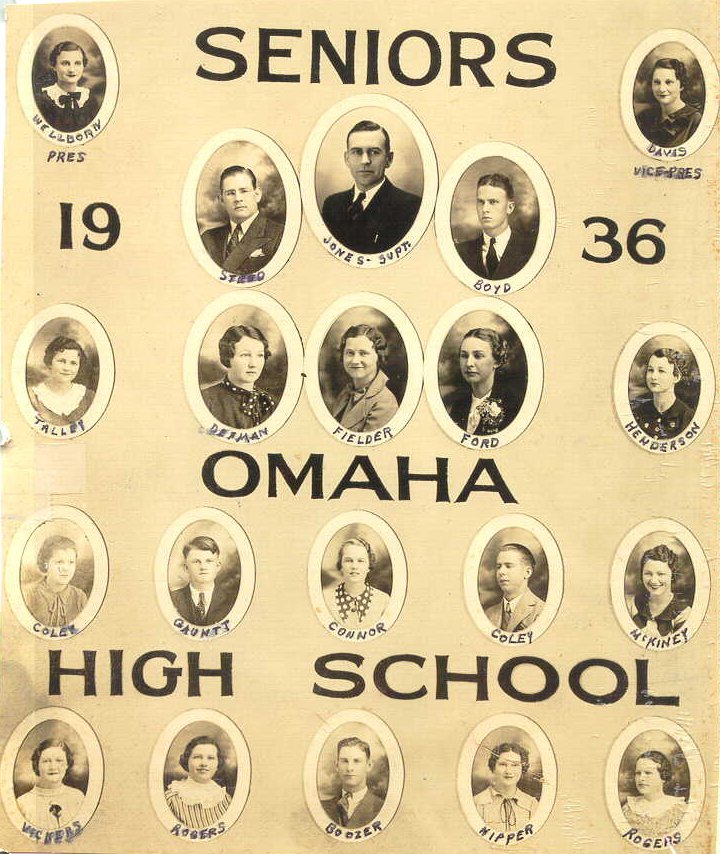
The above photo is of the Omaha graduating class of 1936.
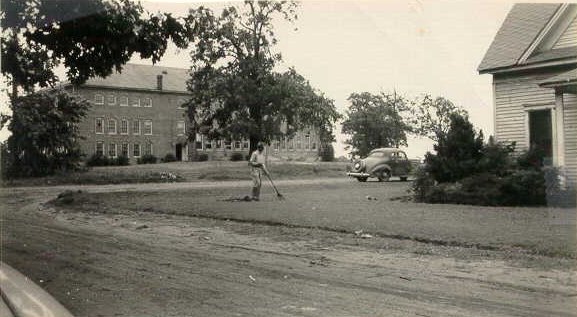
This photo was taken about 1940 in the neighborhood of the Omaha School. The fellow raking his yard is T.L. Moon.
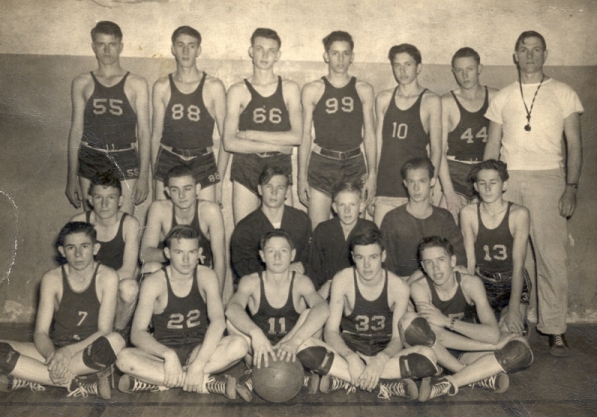
This is a photo of the 1946-47 Omaha basketball team. In the front row from left to right are: Frank Clayton, Ravel Stroman, Charles "Sonny" Slider, Eddie Wallace & Bobby Richards. In the middle row are: Earl Hart Pate, Glen "Bo" Collins, Robert Laney, George Moore, Bobby Alford & Bill Vickers. In the back row are: J.L. Waits, Milton Carpenter, Billy Roberts, Richard Ramage, Herbert Joe Tucker, Leon Godwin and Coach J.P. Vinson. Photo courtesy of Mrs Bo Collins.
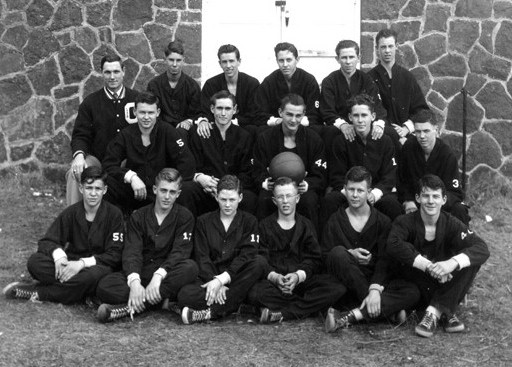
The above photo is of the 1947 Omaha basketball team. The fellows in the photo beginning in the front row from left to right are: Jack Smith, Donald Merrill, Charles H Barrier, Anthony Richards, J. Royce Thigpen, and Thomas Hall. In the second row are: Ravel Stroman, Ollie Pate, Glen Collins, Bill Vickers, and Edwin H. Wallace. In the top row are: Coach J.P. Vinson, Glenn Wright, Bobby Richards, Joe Tucker, Frank Clayton, and Bobby Alford.
As a note, the last basketball game of the Omaha School was played against Avinger and the score was 17-16 in favor of Omaha.
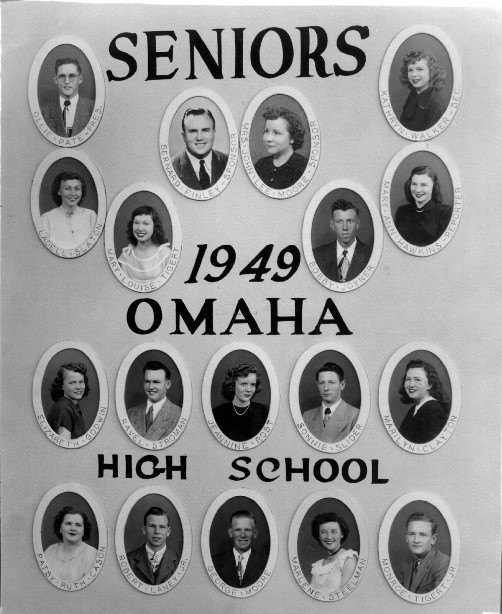
The above is the Omaha graduating class of 1949.
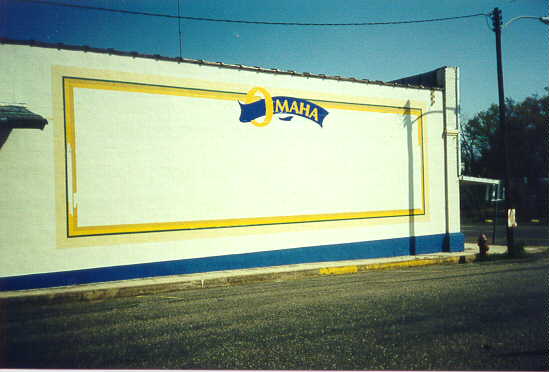
March 7, 2000------I drove through Omaha today taking photographs and noticed a sign or mural being painted on the side of Duncan's Furniture Store. All that had been painted so far
is "OMAHA, 100 years" with a border. Might be something to watch. I will check the sign periodically for progress. Then again, it may be just an ad. (Since I entered this information, I have
heard rumors that it has been taking some effort to get the artist back up here to complete the mural. There has been some minor things done to it since I first saw it, like the border was completed and "100 Years" was added. This information is as of June 10, 2000)
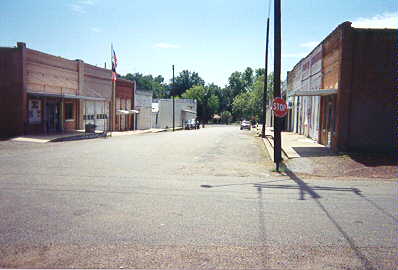
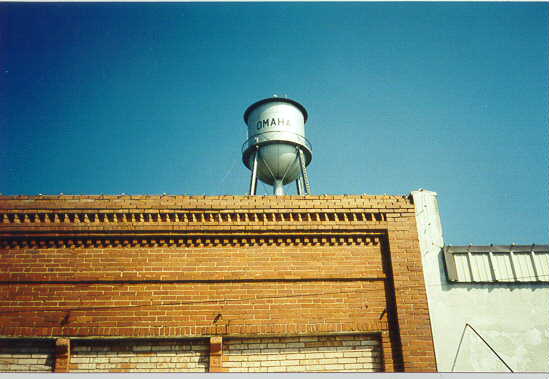
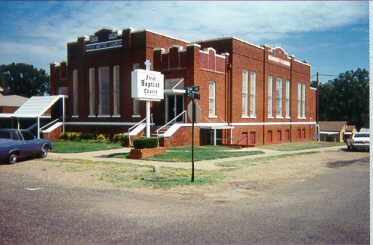
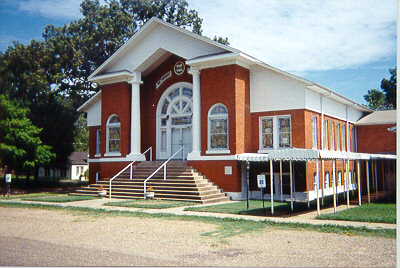
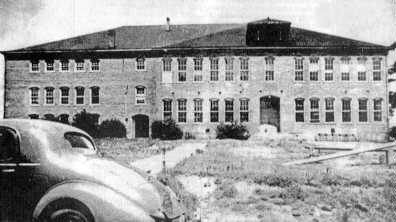
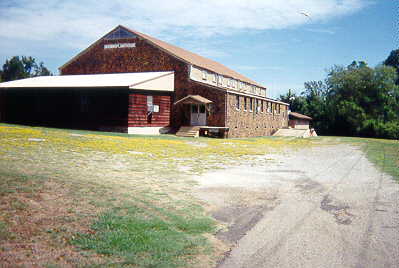
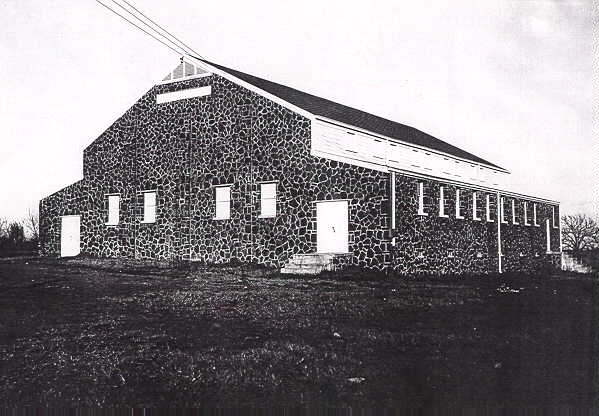

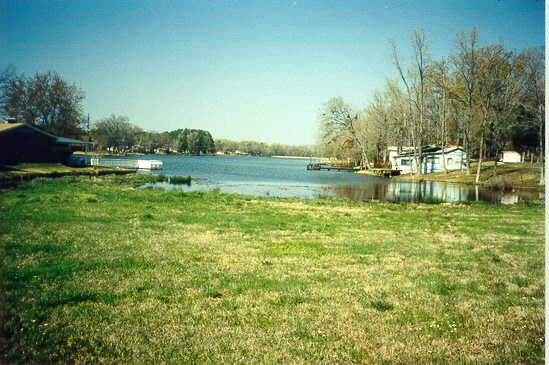
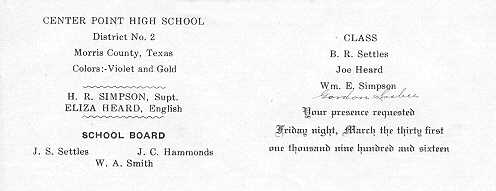
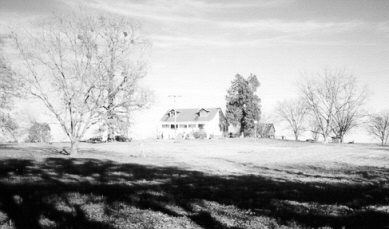
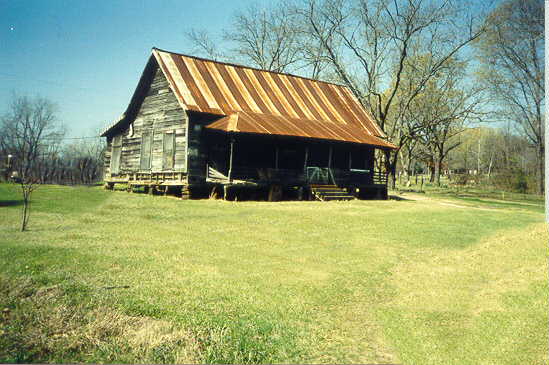

A photo of the old syrup mill located adjacent to the old Motley house above.
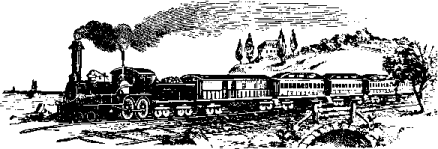
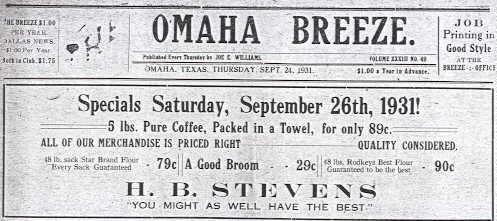
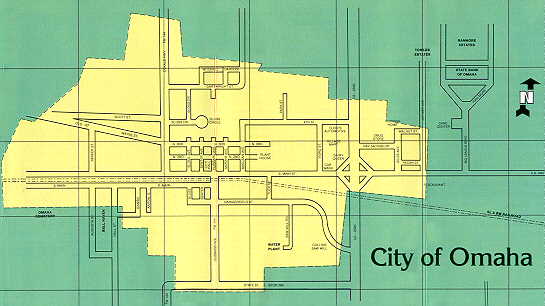


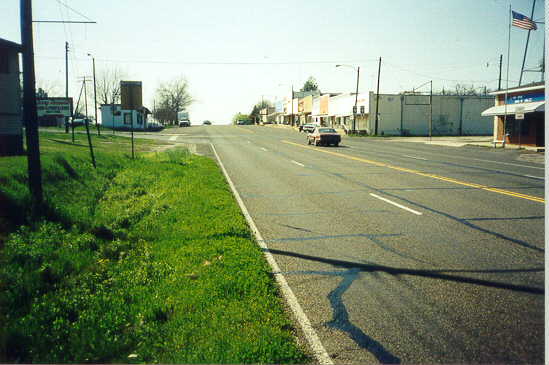
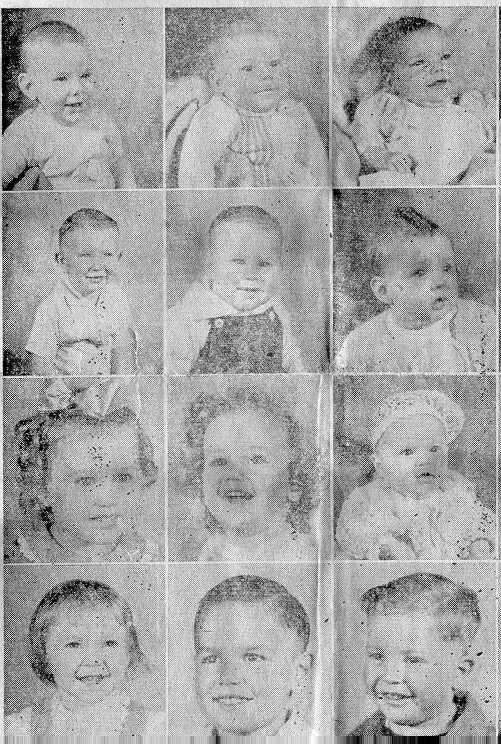
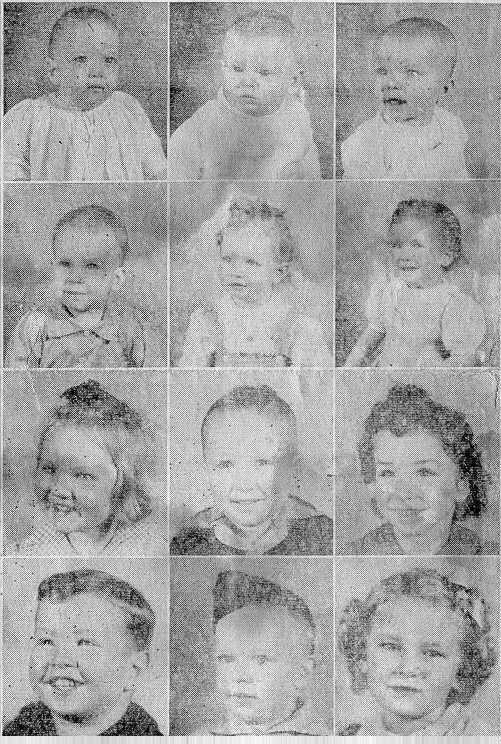
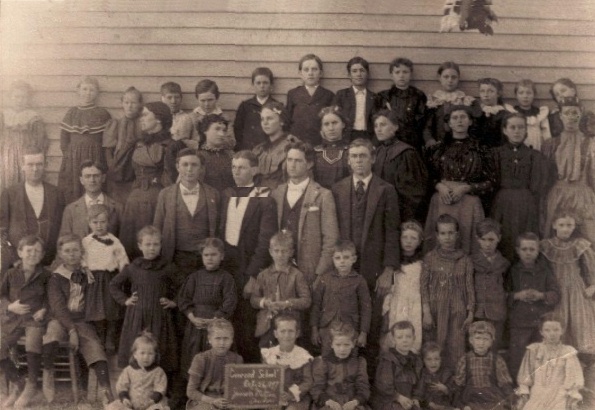
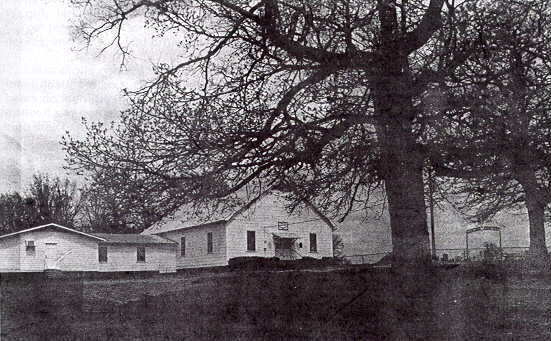
Concord Meeting House and Cemetery:
A Historical Overview
"Today the Concord Meeting House and Cemetery is a landmark which is of both historical and cultural significance to Morris County and the adjoining area. Unfortunately most of the early records of the organization of the church at Concord have been lost. It is believed that the first meeting house was a log cabin located just north of the present site. The present building was built around 1860 and remodeled in 1920. Original materials were used wherever possible. This area of Morris County was first settled by John V. and Nancy P. Cherry in the 1830's. Mr. Cherry served in the Texas War for Independence and in 1838 traveled from his home to Nacogdoches where he served the Republic of Texas as "interpreter to the Indians". In 1843 Mr. Cherry was elected pastor of the Baptist Church of Bethlehem which met in the homes of the members and in schools in the present Morris County. In 1846 Major John Pollard Gaines of the 1st Regiment, Kentucky Volunteer Cavalry marched through this area and recorded in his diary "...traveled 18 miles and camped at Cherry's apparently a clever man and a Baptist preacher, the first divine I have seen in Texas and the second since I left Memphis..." The camp of Major Gaines was located in the vicinity of the present Concord community. Boston, Daingerfield, and Clarksville were the only towns; Mt. Pleasant and Gilmer were in the process of being laid out as the county seats of Titus and Upshur Counties. An occasional Indian was seen in the forests along Boggy, Swanane, Sulphur and Cypress. There were few cleared fields in cultivation and the homes of the pioneers were very scattered. During the next ten years settlers from east of the Mississippi moved into the area and the forests began to disappear into orderly cultivated fields of cotton, corn, wheat and oats. A college and boarding school and a factory for the production of corn mills and cotton gins located in Daingerfield. A stage coach line began regular runs from Jefferson to Clarksville through Daingerfield and Mt. Pleasant. The distance travelled necessitated many intermediate stops and the town of Snow Hill, Titus County was designated one of these stops. Several miles north of Snow Hill construction started on a frame meeting house to be called Concord. Britton Coffey, who is buried in Concord Cemetery, donated land for the meeting house and adjoining cemetery. (The Coffey family was among the first settlers of Morris County. They are identified with the churches at New Hope near the [former] Hospital in the Pines and with Spring Hill, as well as Concord.) Residents of the area built the meeting house of local materials--perhaps the logs were cut on site and hauled by oxen to the nearest sawmill at Snow Hill where the logs were sawed into rough lumber and planed by hand. Again the finished lumber was hauled to the site of the meeting house and a building was erected. Benches and tables were also built for the meeting house was to serve as a school as well as a church. It is thought that the first sermon preached in the Concord Meeting House was by the Rev. C.D. Myers in 1857. At this time, Morris, Titus, and Fannin Counties were all Titus County, and the total population was less than 10,000 people. Meeting houses were used by all denominations and were called Union Churches for preachers were scarce and the people desired the Word of God from any who preached. Then came the period of the War between the States and Reconstruction. Ten per cent or more of the total population of Titus County enlisted in the army of the Confederate States of America. The entire county was desolate of young men; farming operations began to change from cotton to corn, wheat and oats which were shared with families fleeing from the war torn states east of the Mississippi River. The Confederacy enacted tax in kind laws where a tithe of all farm produce, cattle and livestock was collected for the war effort; prices soared and excess food, cloth and transportation were not to be found in the county. Each mail brought news of war casualties to the community and finally in April, 1865 came the news of the surrender at Appamatox. Many of the original families of the community moved West to begin a new life and from the Eastern States came another generation of pioneers into the area. With Reconstruction came military occupation--local elected officials were deposed from office. In 1868 first a Sergeant and then a Corporal of the US Army was appointed Sheriff of Titus County. With military occupation came lawlessness and corruption but still the Meeting House at Concord stood-a landmark for that which is good and right. In the Snow Hill community an ex-soldier of the Confederacy, Solomon Hayes Price, was converted from a fighting, drinking man to a militant soldier of the cross. Four years later, in 1874 Sol Price was ordained a minister by the Concord Church. From all that has been said and written about Soloman Hayes Price, he must have been a wonderful man. At the time of his conversion he could neither read nor write, but with the help of his wife and with the Bible as a tool, he became one of the best known and well liked preachers of this area. He served the Concord Church as pastor from 1874 until 1913. During his 47 years in the pulpit he served as pastor of 15 other churches. A few days before his 82nd birthday and six weeks prior to his death in November, 1921, Price preached the Introductory Sermon for the Hopewell Association in session at Nevil's Chapel. Morris County was created from the County of Titus in the Spring of 1875. The newly created county was divided into voting precincts and the several voting places of the county were designated. The voting places designated were: "...East of the Sedicum Line--at C.P. Forsythe's store and West of the Sedicum Line--Concord Meeting House..." The Concord Meeting House served the area as a school, music school, voting place, community center, and place of worship. In 1919 the orignal frame meeting house was remodeled, using the original lumber whenever possible. Dedicatory services for the remodeled building were held in January, 1920, by Rev. J.W. Brewer of Paris assisted by Rev. Pender of Greenville. The preachers of the Church at Concord, as taken from the church minutes, are listed below. (A question mark indicates that years of service are not certain since some of the church records are missing.) Concord Church was built in 1857. C.D. Myers preached the first sermon. S.H. Price 1874-1913(also served 15 other Churches); J.L. Spence, 1887-??; T.R. Bolin, 1914-1916; A.J. Finley, 1916-1923; J.S. Caldwell, 1923-1925; G.F. Lee, 1925-1927?; T.R. Bolin, 1927-1930?; J.S. Caldwell, 1930-1935; A.J. Finley, 1935-1937; T.P. Lee, 1937-1939; Eugene McClung, 1940-1942; C.W. Gilbreath, 1943-1944; T.P. Lee, 1944-1946; C.W. Gilbreath, 1946-1947; C.O. Rhyne, 1947-1949; Garland Walker, 1950-1951; H.L. McNish, 1951-1952; J.C. Askew, 1953-1954; O.L. Kennedy, 1954-1955; James Wommack, 1955-1958; Curtis Hall, 1958-1959; Wilmer Biddy, 1959-1962; James Wommack, 1962-1964; Charles Swilling, 1964-1968; M.C. McNeil, 1968-1970; Dale Reed, 1970-1972; Glenn R. Griffith, 1972-1975; Carroll W. Jones, 1976-1979; Glenn R. Griffith, 1979-Present Pastor. Among the many pioneers of Texas buried in the cemetery adjoining the churchyard is Major William H. Moore, a veteran of the Texas and Mexican Wars. Major Moore enlisted in the Army of the Republic of Texas at Victoria, Texas, in May, 1836. He served as a Lieutenant in Captain W.E.Harrold's Company of Colonel Felix Houston's Regiment of Cavalry. Later he served in Major W.H. Smith's Battalion and in 1841 he was a member of the Morehouse Expedition into Mexico. Also, buried here are: Col. John V. Cherry--soldier of the Texas War of Independence, interpreter for the Indians, and the first pastor of the Baptist Church at Bethlehem; Nancy P. Cherry, wife of John V. Cherry; and Brinton Coffey who gave the land for the Concord Meeting House and cemetery. On April 8, 1957, the deed for the land on which the Concord Church and cemetery is located was filed with Audrey Mae Childress, Morris County Clerk. The deed made by Brinton Coffey "to the surrounding community" was found by Dee W. Tigert among old papers filed in the State Bank of Omaha. Mrs Joe Richey, who worked in Daingerfield at the time, had previously looked through the old records and had found no record of the deed. The deed was made before Morris became a separate county from Titus, and although many records had been transferred from Titus to Morris, the deed from Brinton Coffey was not among those transferred. The Concord Meeting House was recognized as a historical landmark for more than an hundred years and was awarded the Texas Historical Medallion on October 23, 1966. (Information for this history was taken from the notes of Mr. T.W. Connor, Jr.--Chairman of Morris County Historical Survey Committee in 1966--and from research in church minutes, etc. Any errors are not intentional but are due to misinformation or lack of information.) --Mrs. Janette Tigert Cook"
I have received information that John V Cherry is buried in the Cherry Family Cemetery located about a mile southwest of the church and not in the Concord Church cemetery, but Mrs Nancy P. Cherry IS buried at the Concord Church cemetery. And the building has again been remodeled since the 1980 writing.
 Wheatville
Wheatville
 History of Naples
History of Naples
 Pewitt Page
Pewitt Page
 Remembering P.H.S.
Remembering P.H.S. Trivia & Tidbits
Trivia & Tidbits
 Naples Photos
Naples Photos
 More Photos
More Photos
 Marietta
Marietta
 More Old Naples Photos
More Old Naples Photos
 Rocky Branch
Rocky Branch
 One Hundred Years Ago
One Hundred Years Ago
 Twix the Crix
Twix the Crix Reunions
Reunions 